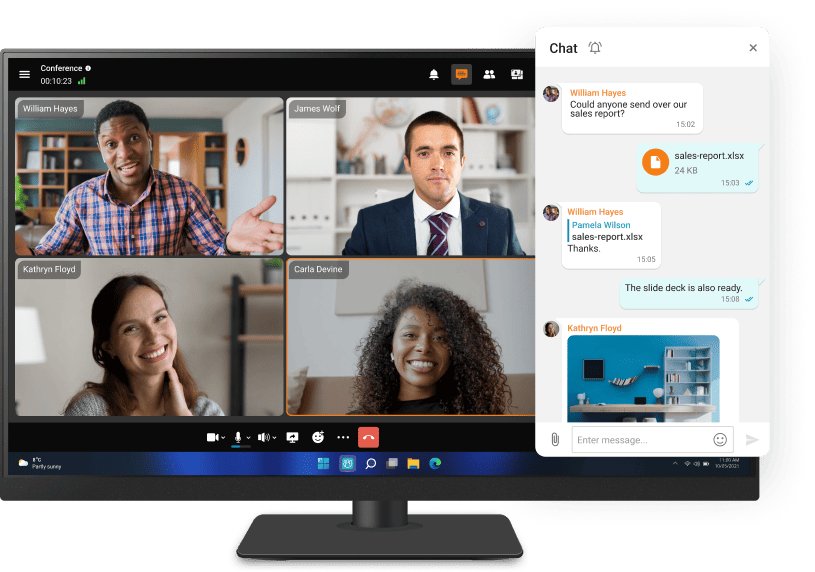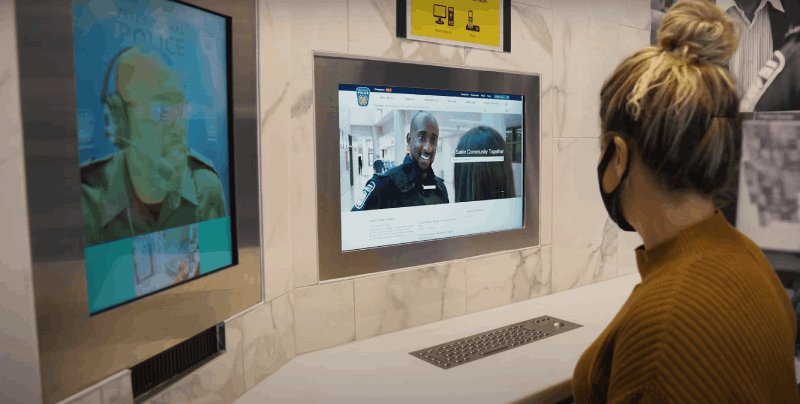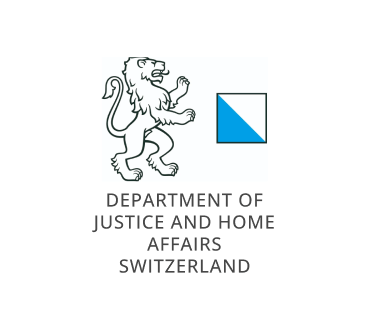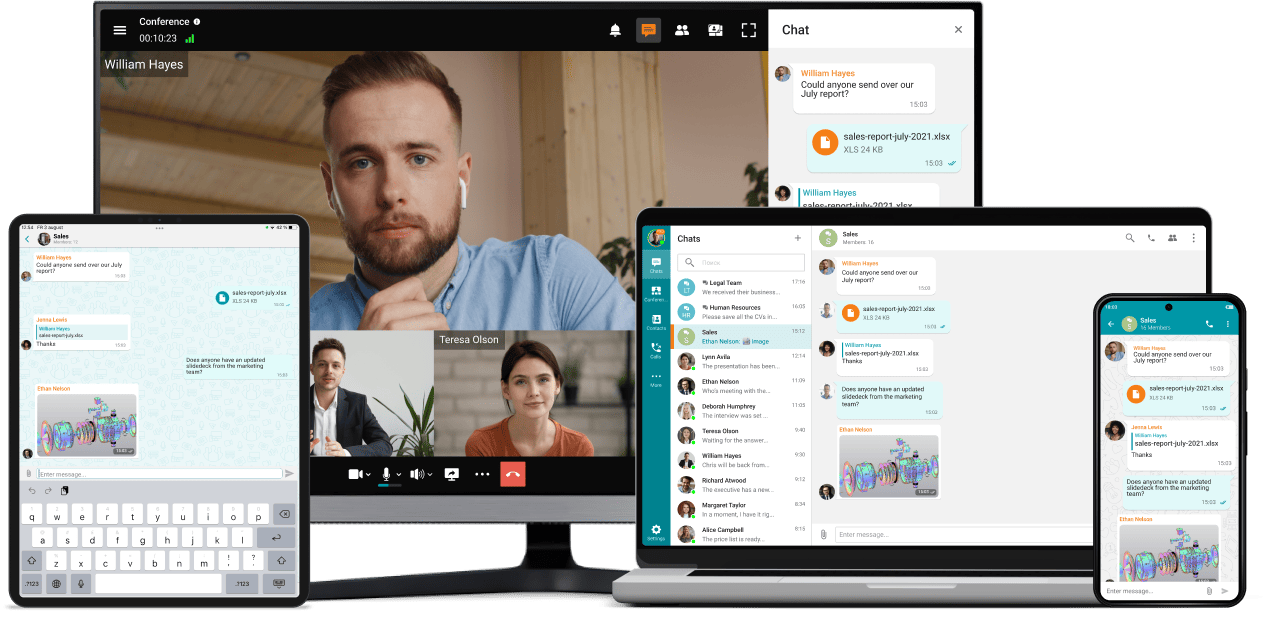TrueConf
TrueConf 2025 में प्रमुख Skype विकल्पों में से एक बना रहता है, विशेष रूप से उन संस्थानों के लिए जो सुरक्षा, प्रदर्शन, और अपनी डिजिटल संचार पर पूर्ण नियंत्रण पर जोर देते हैं। यह ऑन-प्रिमाइसेस डिप्लॉयमेंट को सक्षम बनाता है, जिससे संगठनों को अपनी आंतरिक अवसंरचना के भीतर वीडियो कॉन्फ्रेंसिंग सिस्टम चलाने की क्षमता मिलती है। यह अधिकतम डेटा सुरक्षा, ऑफ़लाइन संचालन, और सख्त सुरक्षा आवश्यकताओं के अनुपालन की गारंटी देता है।
4K अल्ट्रा HD वीडियो जैसी क्षमताओं, एक ही सम्मेलन में 1 500 प्रतिभागियों तक के समर्थन, और मूल SIP/H.323 एकीकरण की विशेषता, TrueConf सरकारी एजेंसियों, स्वास्थ्य संस्थानों, शैक्षिक संगठनों और बड़े उद्यमों के लिए उपयुक्त है। यह AI-संचालित प्रतिलेखन, स्क्रीन साझाकरण, बैठक रिकॉर्डिंग और वर्चुअल बैकग्राउंड जैसी विशेषताओं का भी समर्थन करता है, इसे पेशेवर सहयोग के लिए Skype और Teams का एक मजबूत, स्व-होस्टेड विकल्प बनाता है।
Microsoft Teams
Microsoft Teams, Skype for Business का उत्तराधिकारी के रूप में Microsoft द्वारा नामित, 2025 में प्रमुख डिजिटल संचार केंद्रों में से एक है। यह संदेश, ऑनलाइन बैठकें, ऑडियो संवाद, और उत्पादकता कार्यों को एकीकृत करता है, जो Microsoft 365 सेवाओं (जैसे Outlook, Excel, Word, और SharePoint) के साथ बिना किसी रुकावट के समन्वयित है।
टीम्स निजी चर्चाओं से लेकर एंटरप्राइज़-स्तरीय प्रसारणों और मिश्रित-प्रारूप सम्मेलनों तक सब कुछ सक्षम करता है, और दस्तावेज़ आदान-प्रदान, डिस्प्ले शेयरिंग, सत्र कैप्चर, खंडित चर्चाएं, और साझा फ़ाइलों के भीतर एक साथ संपादन जैसे उपकरण प्रदान करता है।
क्लाउड-प्रथम संरचना पर निर्मित, यह भौगोलिक रूप से बिखरी या मोबाइल कार्यबल के लिए अनुकूल है और व्यवसाय, शिक्षा और सार्वजनिक क्षेत्र के क्षेत्रों में व्यापक रूप से अपनाया गया है। अपनी शक्ति के बावजूद, यह निरंतर कनेक्टिविटी पर निर्भर करता है और उन संस्थानों के लिए उपयुक्त नहीं हो सकता जो ऑफ़लाइन क्षमता की मांग करते हैं या आंतरिक होस्टिंग परिदृश्यों की आवश्यकता होती है जहाँ TrueConf जैसे विकल्प बेहतर अनुकूलता प्रदान करते हैं।
Google Meet
Google Meet गूगल का प्रमुख कॉन्फ्रेंसिंग समाधान है और Google Workspace पारिस्थितिकी तंत्र का एक प्रमुख घटक है। यह व्यक्तियों को किसी भी समर्थित ब्राउज़र या हैंडहेल्ड डिवाइस से सीधे एन्क्रिप्टेड, उच्च-परिभाषा वीडियो सत्र शुरू करने की अनुमति देता है—कोई अतिरिक्त डाउनलोड आवश्यक नहीं है।
मीट त्वरित टीमवर्क के लिए अच्छी तरह से काम करता है, जिससे सामग्री साझा करना, रीयल-टाइम उपशीर्षक, परिवेशी ध्वनि फ़िल्टरिंग और Google कैलेंडर के माध्यम से एकीकृत बैठक समन्वय जैसी क्षमताएं प्रदान करता है। यह आकस्मिक और पेशेवर दोनों परिदृश्यों को समायोजित करता है, चयनित वर्कस्पेस टियर में 1,000 प्रतिभागियों तक की क्षमता के साथ।
क्लाउड-नेटिव पेशकश के रूप में, Google Meet उपयोग में सरलता और Gmail, Docs, और Drive के साथ सहज कनेक्टिविटी के लिए विशेष है। फिर भी, यह व्यापक स्थानीय परिनियोजन का समर्थन नहीं करता है, जिससे उन क्षेत्रों के लिए कम अनुकूल बन जाता है जिन्हें बुनियादी ढांचे और डेटा पर पूर्ण अधिकार की आवश्यकता होती है, ऐसे मामलों में जहाँ TrueConf या Microsoft Teams जैसे विकल्प अधिक मजबूत एंटरप्राइज़-ग्रेड कार्यक्षमता प्रदान करते हैं।
Zoom
ज़ूम 2025 में सबसे व्यापक रूप से अपनाए गए कॉन्फ्रेंसिंग प्लेटफॉर्म में से एक बना हुआ है, जो स्थिरता, सरलता, और उत्कृष्ट वीडियो और ऑडियो गुणवत्ता के लिए सराहा जाता है। यह छोटी निजी सत्रों से लेकर एंटरप्राइज़-स्तरीय वेबिनार और ऑनलाइन सभाओं तक कुछ भी संभालता है, जिसमें कंटेंट डिस्प्ले, ब्रेकआउट ज़ोन, रिमोट रिकॉर्डिंग, विज़ुअल बोर्ड और इंटरएक्टिव मैसेजिंग जैसे उपकरण प्रदान किए जाते हैं।
ज़ूम ने ज़ूम वर्कप्लेस में रूपांतरित होकर उत्पादकता सुविधाएँ जैसे ज़ूम मेल, शेड्यूलिंग और टीम स्पेसेज़ प्रदान की हैं, जिससे यह एक सामान्य वीडियो प्लेटफ़ॉर्म से अधिक बन गया है। यह स्लैक, गूगल वर्कस्पेस और माइक्रोसॉफ्ट 365 सहित बाहरी सेवाओं के साथ जुड़ता है, और कॉर्पोरेट, शैक्षणिक और चिकित्सा वातावरण में अपनी मजबूत उपस्थिति बनाए रखता है।
हालांकि Zoom बड़ी लचीलेपन और सहज पहुंच की पेशकश करता है, यह ज्यादातर क्लाउड-निर्भर रहता है, और पूर्ण ऑन-प्रिमाइसेस इंफ्रास्ट्रक्चर समर्थन की कमी है। संस्थाओं के लिए जिन्हें सख्त अनुपालन मांगों के तहत स्थानीय रूप से होस्ट की गई प्रणालियों या ऑफ़लाइन क्षमता की आवश्यकता होती है, TrueConf जैसे विकल्प एक मजबूत एंटरप्राइज-ग्रेड समाधान प्रस्तुत कर सकते हैं।
Webex Meetings
Webex Meetings सिस्को का एंटरप्राइज़-स्तरीय वीडियो सहयोग समाधान है, जिस पर विश्व भर की कंपनियां, एजेंसियां और संगठन भरोसा करते हैं। यह पृष्ठभूमि दमन, त्वरित लिप्यंतरण और बहुभाषी व्याख्या जैसी बुद्धिमान विशेषताओं द्वारा समर्थित स्पष्ट दृश्य और ध्वनि प्रदान करता है। Webex प्रत्यक्ष चर्चाओं से लेकर व्यापक डिजिटल सभाओं तक सब कुछ सक्षम बनाता है, प्रदर्शन साझा करने, सहयोगी चित्रण और खंडित ब्रेकआउट समूहों जैसी कार्यक्षमताओं की पेशकश करता है।
Webex बड़े Webex Suite का हिस्सा है, जिसमें मैसेजिंग, वॉयस सेवाएं, डिजिटल इवेंट्स और हार्डवेयर सिंक्रोनाइज़ेशन शामिल हैं। यह Cisco के प्रमाणित उपकरणों के साथ मजबूती से एकीकृत होता है और Microsoft 365, Google Workspace और Salesforce CRM जैसे इकोसिस्टम के साथ कनेक्शन की अनुमति देता है।
मानक क्लाउड-अनन्य सेवाओं के विपरीत, Webex हाइब्रिड और स्थल-होस्टेड कॉन्फ़िगरेशन का समर्थन करता है, जिससे संस्थानों को डेटा प्रबंधन और नीति अनुपालन पर अधिकतम अधिकार मिलता है। इसे उन्नत सुरक्षा प्रोटोकॉल द्वारा शासित उद्योगों के लिए एक पसंदीदा प्लेटफॉर्म के रूप में स्थापित करता है।
Jami
जामी एक पूरी तरह से ओपन-सोर्स, वितरित संचार समाधान है और 2025 में एक उल्लेखनीय Skype विकल्प है। यह सुरक्षित वॉयस कॉल, वीडियो मीटिंग्स, समूह सहयोग, मैसेजिंग, दस्तावेज़ विनिमय, डिस्प्ले शेयरिंग, और SIP कार्यक्षमता प्रदान करता है, बिना केंद्रीकृत बुनियादी ढांचे पर निर्भर हुए।
अपने विकेन्द्रीकृत डिज़ाइन के कारण, Jami आंतरिक नेटवर्क के भीतर ऑफ़लाइन सहजता से काम करता है और पंजीकरण के दौरान कोई व्यक्तिगत विवरण एकत्र नहीं करता है। Linux, Windows, macOS, Android, iOS और अन्य प्लेटफार्मों पर उपलब्ध, यह उन उपयोगकर्ताओं और संस्थानों के लिए उपयुक्त है जो गोपनीयता को प्राथमिकता देते हैं। उन परिवेशों के लिए जिन्हें खाता निगरानी या उद्यम-स्तरीय प्रशासन की आवश्यकता होती है, Jami में एक सर्वर-पक्ष उपकरण (JAMS) है जो LDAP या Active Directory सिस्टम के साथ जुड़ने के लिए उपयुक्त है।
Slack
Slack, Salesforce द्वारा प्रबंधित एक ब्राउज़र-आधारित टीम इंटरेक्शन प्लेटफॉर्म है, जिसे मुख्य रूप से कार्यस्थल संचार के लिए बनाया गया है। यह संगठित चैनल और निजी संदेश, हडल्स के माध्यम से एम्बेडेड ऑडियो/वीडियो (स्क्रीन प्रसारण के साथ तुरंत वॉयस या वीडियो सत्र शुरू करना) को सक्षम बनाता है, साथ ही गतिशील सामग्री विनिमय और 2,000 से अधिक तृतीय-पक्ष ऐप कनेक्शन प्रदान करता है।
कॉरपोरेट-स्तरीय सुरक्षा के साथ—जिसमें स्थानांतरण और भंडारण के दौरान एन्क्रिप्शन, सिंगल साइन-ऑन (SSO), दो-कारक प्रमाणीकरण, एंटरप्राइज की सिस्टम्स, डेटा लॉस प्रिवेंशन, गतिविधि लॉग्स, और नियामक प्रमाणपत्र शामिल हैं, Slack उन उद्यमों के लिए तैयार किया गया है जिन्हें मजबूत निगरानी और गोपनीयता मानकों की आवश्यकता होती है (स्रोत: connecteam.com)। हाल के सुधार (जून 2025 तक) AI-आधारित अतिरिक्त जैसे स्मार्ट मीटिंग सारांश, Salesforce समन्वय, और सुरक्षा और कार्यक्षेत्र निगरानी के लिए उन्नत ढांचे पेश करते हैं।
सिंक और विलंबित आंतरिक चर्चाओं के लिए आदर्श, स्लैक के फायदे चुस्त टीमवर्क, स्वचालित वर्कफ़्लो और बाहरी सेवाओं के साथ शक्तिशाली कनेक्शनों में निहित हैं। हालाँकि, इसका नेटिव वीडियो (हडल्स) काफी सीमित है, इसमें उच्च-स्तरीय सम्मेलन सुविधाओं की कमी है, इसलिए कई संगठन बड़े पैमाने पर वर्चुअल इवेंट्स के लिए स्लैक को ज़ूम या वेबेक्स जैसी उन्नत प्लेटफार्मों के साथ जोड़ते हैं।
WeChat
WeChat Tencent का ऑल-इन-वन "सुपर-ऐप" है, जो चैट, वीडियो/ऑडियो कॉलिंग, सामाजिक इंटरैक्शन, वित्तीय लेनदेन (WeChat Pay), एम्बेडेड ऐप्स और अतिरिक्त उपकरणों को एकीकृत वातावरण में एक साथ जोड़ता है। यह सुरक्षित व्यक्तिगत और समूह वीडियो चर्चाओं, वॉइस क्लिप्स, सामग्री साझा करने, स्थान सुविधाओं और Moments के माध्यम से सोशल फ़ीड अपडेट को सक्षम बनाता है।
हर महीने 1 बिलियन से अधिक सक्रिय सदस्यों के साथ, WeChat रोजमर्रा की दिनचर्या में मजबूती से समाया हुआ है, विशेष रूप से चीन में, संदेश भेजने, वाणिज्य, और डिजिटल उपयोगिताओं के लिए एक केंद्र के रूप में। उद्यमों के लिए, यह ग्राहकों से जुड़ने, संचालन प्रबंधित करने, और आंतरिक कार्यों को सरल बनाने के लिए सत्यापित प्रोफाइल, स्टोरफ्रंट्स, मिनी प्रोग्राम्स, और WeCom (एंटरप्राइज WeChat) प्रदान करता है।
फिर भी, यह प्लेटफ़ॉर्म अंतरराष्ट्रीय स्तर पर सीमित सुरक्षा उपाय और डेटा सुरक्षा प्रदान करता है, जिसमें एंड-टू-एंड एन्क्रिप्शन की कमी है और नियामक निगरानी की अनुमति देता है। यह चीन के डिजिटल परिदृश्य के भीतर काम कर रहे दर्शकों के लिए सबसे व्यावहारिक है, लेकिन सख्त डेटा गवर्नेंस की आवश्यकता वाले अनुपालन-संचालित या गोपनीयता-केंद्रित उपयोग मामलों के लिए कम उपयुक्त है।
WhatsApp
व्हाट्सएप 2025 में अग्रणी अंतरराष्ट्रीय संचार प्लेटफार्मों में से एक बना हुआ है, जो सुरक्षित अंत-से-अंत एन्क्रिप्टेड मैसेजिंग, वॉइस और वीडियो बातचीत, समूह ऑडियो रूम, मीडिया साझाकरण, और स्वचालित रूप से हटने वाले संदेश प्रदान करता है, जो सभी डिफ़ॉल्ट रूप से सिग्नल प्रोटोकॉल फ्रेमवर्क का उपयोग करके सुरक्षित हैं। यह नियमित रूप से गोपनीयता-केंद्रित उन्नयन जारी करता है जैसे एडवांस्ड चैट कंट्रोल्स (एंटी-फॉरवर्डिंग, कोई एआई एकीकरण नहीं) और सभी समुदायों के लिए मौन आवाज़ स्थान।
उद्यमों के लिए, WhatsApp एक शक्तिशाली जुड़ाव और आउटरीच चैनल के रूप में कार्य करता है: 50 मिलियन से अधिक छोटे ब्रांड इसके बिजनेस प्लेटफॉर्म पर निर्भर करते हैं, जिसमें मजबूत API एक्सेस, AI-सहायता प्राप्त कॉलिंग फंक्शन, और प्रति-इंटरैक्शन बिलिंग और स्टेटस फीड्स और चैनल स्पेसेज़ के भीतर प्रमोशनल कंटेंट जैसे बढ़ते राजस्व उपकरण शामिल हैं।
हालांकि यह वैश्विक पहुंच, सरलता, और एन्क्रिप्शन की मजबूती में उत्कृष्ट है, व्हाट्सएप निजी सर्वर परिनियोजन का समर्थन नहीं करता है, जिससे यह उन संगठनों के लिए कम उपयुक्त हो जाता है जिन्हें व्यापक बुनियादी ढांचे की निगरानी की आवश्यकता होती है, जहां TrueConf या वेबएक्स जैसी विकल्प अधिक परिचालन स्वायत्तता प्रदान करते हैं।


































